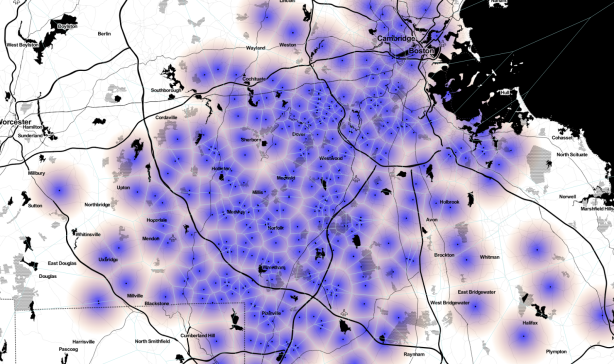Last week, post Boston Code Sprint, I spent a couple of hours playing with bee data, specifically bee keeper data for Norfolk County Massachusetts.
My friend Eric (a bee keeper of 4 hives in said county) says that worker bees can fly as far as 3 miles for nectar, but after that approximate limit, they hit diminishing returns relative to the calories they burn.
Proximity of bee hives is important for reasons of competition (although bees are quite friendly with each other on the flower) but also disease transfer, which in this age of not-so-easy bee keeping, is an important factor. So we set out to map bees.
With a list of addresses, QGIS, and the mmqgis extension (see Plugins:Fetch Python Plugins) which uses Google services for address lookup, we get a nice little set of points for beekeepers in Norfolk County.
Having a good context map for any such set of points is important. This is the part of the project I worried most about. Fortunately, we also have the OpenLayers Plugin, which allows us to add a number of web maps as background (BTW, when we want print quality maps down the road, this will cause us suffering, but for now it is a nice stand-in for a good base layer). We decided the colorless Stamen Toner map was perfect for our purposes.
Now, let’s buffer these points– give those bees 1.5 miles of free reign, and see where the overlaps in range are (we could make these 3 mile radii, but you get the point):
The map tells us something of overlapping ranges, etc., but it seems like we could use something like we could do something more sophisticated. Anyone who has followed my blog for a while will not be surprised by the employment of Voronoi polygons… .
Eric, having suffered an explanation of different ways to calculate Voronoi earlier in the week, remembered the relationship between buffers and Voronoi, and asked if we could combine them. In this case, picture soap bubbles of your youth. Blow a soap bubble for each bee point, and the walls of bubbles in between form Voronoi polygons. In our case, we use cones instead of soap bubbles, but after a couple hours of playing in PovRay, we made some code like this:
#version 3.6;
// Pov Includes
#include “colors.inc”
#include “transforms.inc”
#include “cone_coords.inc”
#declare Camera_Size = 500000; //freekin huge
background {color <0, 0, 0>}
//Set the center of image
#declare scene_center_x=759496;
#declare scene_center_y=2861454;
#declare Camera_Location = <scene_center_x,5,scene_center_y> ;
#declare Camera_Lookat = <scene_center_x,0,scene_center_y> ;
// Use orthographic camera for true plan view
camera {
orthographic
location Camera_Location
look_at Camera_Lookat
right Camera_Size*x
up Camera_Size*y
}
// Union all the cones together into one object
#declare coner = union {
cone { <0,0,0>,15840,<0,5,0>,0
} };
union {
#declare LastIndex = dimension_size(cone_coords, 1)-2;
#declare Index = 0;
#while(Index <= LastIndex)
object {
coner
translate cone_coords[Index]
}
#declare Index = Index + 1;
#end
// Pigment cones according to distance from camera
pigment {
gradient x color_map {
[0 color Blue ] // Blue to orange will help us employ blue as the alpha values later
[1 color Orange ]
}
scale <vlength(Camera_Location-Camera_Lookat),1,1>
Reorient_Trans(x, Camera_Lookat-Camera_Location)
translate Camera_Location
}
finish {ambient 1}
}
We get a funky result (yes, this is the result I hoped for):
A little transparency, alternate QGIS blending mode, and using the blue band as a transparency band give us a nice output:
We’ll add in those Voronoi boundaries to emphasize the edge of these areas:
And since this is really only meant for Norfolk County bee keepers, and doesn’t represent folks outside that area, we’ll use a mask with a blending mode of “Subtract” to really offset this map:
I will be interested to see if this helps them look at disease control and spread. In case you are wondering, Eric is luck enough to have an almost dedicated area for his bees, which includes a huge wetland complex (think: lots of flowers) that is (in his words) all his own. Well, all his bees own, anyway.










Nice summary, Steve, and I like the Norfolk County mask step!
Me too. It focuses and frames the map nicely.